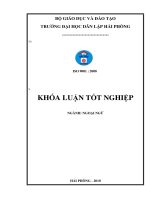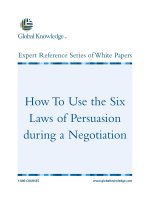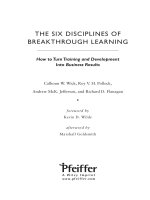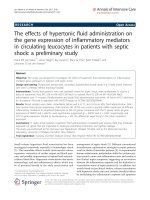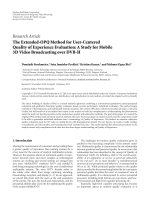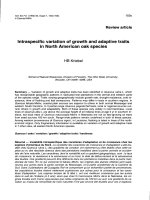The “Six Sins of GreenwashingTM” - A Study of Environmental Claims in North American Consumer Markets potx
Bạn đang xem bản rút gọn của tài liệu. Xem và tải ngay bản đầy đủ của tài liệu tại đây (1.36 MB, 15 trang )
The “Six Sins of Greenwashing
TM
”
A Study of Environmental Claims in North American Consumer Markets
A ‘Green Paper’ by
TerraChoice Environmental Marketing Inc.
(November 2007)
Table of Contents
Overview……………………………………………………… ………………………. 1
Research Methodology…………………………………………………………………. 2
Defining and Quantifying the Six Sins of Greenwashing……… ……………………. 2
Sin of the Hidden Trade-Off ……………………………………………………… 2
Sin of No Proof ……………………………………………………………………
3
Sin of Vagueness ………………………………………………………………….
3
Sin of Irrelevance …………………………………………………… …………….
4
Sin of Lesser of Two Evils………………………………………………………….
4
Sin of Fibbing ……………………………………………………………………
4
Recommendations for Concerned Consumers……………………………………… 5
Recommendations for Marketers………………………………………………………. 7
Concluding Thoughts………………………………………………………………… 8
Appendices……………………………………………………………………………… 9
Appendix A: Types of Products Reviewed
Appendix B: Eco-Labels
Appendix C: References
The Six Sins Of Greenwashing
TM
Green·wash (grēn'wŏsh', -wôsh') – verb: the act of misleading consumers regarding the environmental
practices of a company or the environmental benefits of a product or service.
The “Six Sins of Greenwashing
TM
”
A Study of Environmental Claims in North American Consumer Markets
Overview
The recent surge of environmental awareness in
North America is unmistakable. It has been
documented by many researchers and widely
reported in the popular press. The rise in “green”
marketing claims has also been well documented.
Less studied is the apparent increase in
“greenwashing” – false or misleading green
marketing claims.
In an effort to describe, understand, and quantify
the growth of greenwashing, TerraChoice
Environmental Marketing Inc. conducted a survey of
six category-leading big box stores. Through these
surveys, we identified 1,018 consumer products
bearing 1,753 environmental claims. Of the 1,018
products examined, all but one made claims that are
demonstrably false or that risk misleading intended
audiences.
Based on the survey results, we identified six
patterns in the greenwashing, which we now
recognize as the “Six Sins of Greenwashing
TM
”.
These findings suggest that greenwashing is
pervasive, the consequences of which are significant:
• Well-intentioned consumers may be misled
into purchases that do not deliver on their
environmental promise. This means both that
the individual consumer has been misled and
that the potential environmental benefit of his
or her purchase has been squandered.
• Competitive pressure from illegitimate
environmental claims takes market share
away from products that offer more legitimate
benefits, thus slowing the penetration of real
environmental innovation in the marketplace.
• Greenwashing may create cynicism and
doubt about all environmental claims.
Consumers – particularly those who care
most about real environmental progress –
may give up on marketers and manufacturers,
and give up on the hope that their spending
might be put to good use. This would
eliminate a significant market-based, financial
incentive for green product innovation and
leave committed environmental advocates
with government regulations as the most likely
alternative.
Of the 1,018 products reviewed, all but one
committed at least one of the Six Sins of
Greenwashing.
1. Sin of the Hidden Trade-Off
2. Sin of No Proof
3. Sin of Vagueness
4. Sin of Irrelevance
5. Sin of Fibbing
6. Sin of Lesser of Two Evils
The “Six Sins of Greenwashing
TM
”
© 2007. TerraChoice Environmental Marketing Inc.
All Rights Reserved.
1
The Six Sins Of Greenwashing
TM
Research Methodology
In the spring of 2007, TerraChoice sent research
teams into six category-leading big box stores with
instructions to record every product-based
environmental claim they observed. We instructed the
teams that, for each environmental claim, they should
identify the product, the nature of the claim, any
supporting information, and any references offered
for further information.
After recording 1,753 environmental claims on
1,018 products (refer to Appendix A), we tested the
claims against current best practices in environmental
marketing. The sources for these best practices
include the International Organization for
Standardization (ISO)
1
, the U.S Federal Trade
Commission
2
, U.S Environmental Protection Agency
3
,
Consumers Union
4
, and the Canadian Consumer
Affairs Branch
5
.
Finally, we studied the resulting list of false or
misleading claims for patterns and lessons. We have
come to call these patterns the “Six Sins of
Greenwashing”. Of the 1,018 products that made
environmental claims, all but one committed at least
one of the Six Sins.
Defining and Quantifying the Six Sins of
Greenwashing
Based on our analysis, we categorized the false
or misleading environmental claims into the following
“Six Sins of Greenwashing”:
Sin of the Hidden Trade-Off – The Sin of the
Hidden Trade-off is committed by suggesting a
product is “green” based on a single
environmental attribute (the recycled content of
paper, for example) or an unreasonably narrow
set of attributes (recycled content and chlorine free
bleaching) without attention to other important, or
perhaps more important, environmental issues
(such as energy, global warming, water, and
forestry impacts of paper). Such claims are not
usually false, but are used to paint a “greener”
picture of the product than a more complete
environmental analysis would support.
Here are some examples from the research:
Examples:
♦ Paper (including household tissue, paper towel,
and copy paper) and lumber products (such as
framing products and plywood) that promote their
recycled content or sustainable harvesting
practices without attention to manufacturing
impacts such as air emissions, water emissions,
and global warming impacts.
♦
Household insulation products (such as batt
insulation products for home renovation products)
that claim indoor air quality benefits without
attention to other environmental aspects such as
recycled content and manufacturing impacts.
Sins Committed by Category
The Sin of the
Hidden-Trade Off
57%
The Sin of
Irrelevance
4%
The Sin of Fibbing
1%
The Sin of Lesser of
Two Evils
1%
The Sin of
Vagueness
11%
The Sin of No Proof
26%
© 2007. TerraChoice Environmental Marketing Inc.
All Rights Reserved.
2
The Six Sins Of Greenwashing
TM
♦ Office technology (printers, copiers, fax
machines) that promote energy efficiency without
attention to hazardous material content, indoor
air quality, or compatibility with recycled paper or
remanufactured toner cartridges.
♦ Other product claims that committed this sin
include ink cartridges, laundry detergents, dish
detergent, air fresheners, bathroom cleaners,
markers, flooring laminate, bags, multi-purpose
cleaners, wood panels, and pesticides.
The Sin of the Hidden Trade-off was the most
frequently committed sin in the study, made by 57%
of all environmental claims.
Sin of No Proof – Any environmental claim that
cannot be substantiated by easily accessible
supporting information, or by a reliable third-party
certification, commits the Sin of No Proof. (For this
research, we determined there to be ‘no proof’ if
supporting evidence was not accessible at either the
point of purchase or at the product website.)
Among others, our research found these examples of
the Sin of No Proof:
♦ Household lamps and lights that promote their
energy efficiency without any supporting evidence
or certification.
♦ Personal care products (such as shampoos and
conditioners) that claim not to have been tested
on animals, but offer no evidence or certification
of this claim.
♦ Facial tissues and paper towels that claim post-
consumer recycled content without providing
evidence.
We found a total of 454 products and approximately
26% of the environmental claims committed the Sin of
No Proof; making it the second most frequently
committed sin.
Sin of Vagueness – The Sin of Vagueness is
committed by every claim that is so poorly defined or
broad that its real meaning is likely to be
misunderstood by the intended consumer.
There are some recurring themes within these vague
claims. For example:
♦ “Chemical-free”. In fact, nothing is free of
chemicals. Water is a chemical. All plants,
animals, and humans are made of chemicals as
are all of our products.
♦ “Non-toxic”. Everything is toxic in sufficient
dosage. Water, oxygen, and salt are all
potentially hazardous.
♦ “All Natural”. Arsenic is natural. So are uranium,
mercury, and formaldehyde. All are poisonous.
♦ “Green”, “Environmentally friendly”, and “Eco-
conscious” (to name just a few) which are utterly
meaningless without elaboration.
Some product examples from the research:
♦ Garden insecticides promoted as “chemical-
free”.
♦ “Natural” hair mousse.
♦ Kitchen (wax) paper that claims “recycled
content” but does not quantify it (Would 0.1%
qualify?)
This mobius loop is intended to mean
that the product is made from recycled
material. But is it the whole product, or
the package? And is it made of 100%
recycled material, or less? And is it post-
consumer waste, or post-industrial waste?
Without a qualifying statement, the
symbol is likely to mislead the buyer,
committing the Sin of Vagueness.
© 2007. TerraChoice Environmental Marketing Inc.
All Rights Reserved.
3
The Six Sins Of Greenwashing
TM
♦ General purpose household cleaners that claim
to be “non-toxic” without explanation or third-
party substantiation.
• “100% natural” bathroom cleaners.
In our research sample, 196 individual products (or
11% of the environmental claims) committed the Sin
of Vagueness.
Sin of Irrelevance – The Sin of Irrelevance is
committed by making an environmental claim that
may be truthful but is unimportant and unhelpful for
consumers seeking environmentally preferable
products. It is irrelevant and therefore distracts the
consumer from finding a truly greener option.
The most frequent example of an irrelevant claim
relates to chlorofluorocarbons (CFCs) – a principal
contributor to ozone depletion. Since CFCs have
been legally banned for almost 30 years, there are
no products that are manufactured with it.
Nevertheless, we found many individual products that
presented CFC-free claims as an apparently unique
environmental advantage. They included:
♦ CFC-free insecticides,
♦ CFC-free lubricants,
♦ CFC-free oven cleaners,
♦ CFC-free shaving gels,
♦ CFC-free window cleaners,
♦ CFC-free disinfectants.
The Sin of Irrelevance accounted for 78 products and
4% of the environmental claims.
Sin of Lesser of Two Evils – These are “green”
claims that may be true within the product category,
but that risk distracting the consumer from the
greater environmental impacts of the category as a
whole. Examples include:
♦ Organic cigarettes.
♦ “Green” insecticides and herbicides.
Obviously, there are some circumstances and
consumers that demand these products. Commercial
insecticides and herbicides are essential to some
agricultural applications. In those circumstances,
choosing the greenest option is essential. However,
insecticides and pesticides may be unnecessary for
many cosmetic applications (such as lawns).
Organic tobacco may be a more responsible choice
for smokers, but shouldn’t most consumers be
discouraged from smoking in the first place?
We consider a claim to commit the Sin of Lesser of
Two Evils when environmental qualifiers such as
“organic” or “green” are placed on products in
which the entire product category is of questionable
environmental value.
In this study, 17 products and approximately 1% of
environmental claims committed the Sin of Lesser of
Two Evils.
Sin of Fibbing – The Sin of Fibbing is
committed by making environmental claims that are
simply false.
In our findings, only a few products were found to
commit the Sin of Fibbing. Most of these were
misuse or misrepresentation of certification by an
independent authority. These cases included, for
example:
♦ Several shampoos that claimed to be “certified
organic”, but for which our research could find
no such certification.
♦ A caulking product that claims to be “Energy
Star” registered, but the official Energy Star
website suggests this is false.
♦ A dishwasher detergent that purports to be
packaged in “100% recycled paper”, and yet the
container is plastic.
CFCs have been legally banned
for almost 30 years, yet many
products still claim CFC-free as
if it is a unique competitive
advantage.
© 2007. TerraChoice Environmental Marketing Inc.
All Rights Reserved.
4
The Six Sins Of Greenwashing
TM
10 products (less than 1% of environmental claims)
committed the Sin of Fibbing, making it one of the two
least frequently committed sins.
Recommendations for Consumers
Governments and standard-setting bodies have
attempted to discourage greenwashing. In North
America, both the US Federal Trade Commission
6
and the Canadian Consumer Affairs office
7
have
issued guidelines for proper use of environmental
claims. Under ISO 14024, the International
Organization for Standardization establishes
guidelines for proper use of environmental
information.P
8
But it is our observation that when
environmental interest is high, as it is today,
greenwashing is nevertheless prolific.
If the good intentions of consumers and the
environmental benefits of their choices are not to be
squandered, consumers themselves will have to play
a role. Here are some suggestions that arise from
this study.
1. Look for Eco-labels.
Eco-labelling – standardized by ISO 14024 and
recognized around the world – arose as an answer
to earlier efforts of greenwashing. They remain one
of the most useful tools to avoid greenwashing. Look
for products that have been certified by a qualified
and independent third-party such as EcoLogo
CM
or
Green Seal. Both EcoLogo
CM
and Green Seal
develop standards for environmental leadership in
an open, transparent consensus-based process that
considers multiple environmental issues throughout a
product’s lifecycle (from resource extraction to end-
of-life). These programs deliver a shortcut to
“greener” products through:
• Clear public standards for environmental
leadership in each product category;
• Third-party verification that each certified
product meets the applicable standards;
• Ongoing surveillance auditing to ensure
continued compliance;
• Public listings of certified products.
Additional information on other environmental
standards is included in Appendix B.
Example of Multi-Attribute Eco-labels:
EcoLogo
CM
Green Seal
www.ecologo.org www.greenseal.org
Multi-Attribute Versus Single-Attribute Claims
When seeking environmentally preferable
products, it is important to look at multiple
environmental considerations rather than just single
environmental issues.
As an analogy, when attempting to identify
healthier food choices, it can be useful to look at
calorie content. It is more helpful, however, to also
examine fat, sugar, and vitamin content.
The most respected environmental claims
incorporate multiple environmental considerations
throughout every phase of a product’s life-cycle,
which includes the environmental impacts of the raw
materials, manufacturing process, the product itself,
and its ultimate disposal.
Single-attribute claims look at only a single
environmental issue such as recycled-content or
energy-efficiency. While important, single attribute
claims can hide important additional environmental
considerations.
© 2007. TerraChoice Environmental Marketing Inc.
All Rights Reserved.
5
The Six Sins Of Greenwashing
TM
2. Look For Evidence of Any of the “Six Sins” By
Asking the Following Questions:
a) Is the “green” claim restricted to just one, or a
narrow set of environmental issue(s)? (The Sin of
the Hidden Trade-Off.) If so, you might look for
other information that gives a more complete
picture of the environmental impact of the
product. “Okay, this product comes from a
sustainably harvested forest, but what are the
impacts of its milling and transportation? Is the
manufacturer also trying to reduce those
impacts?” Emphasizing one environmental issue
isn’t a problem (indeed, it often makes for better
communications). Hiding a trade-off between
environmental issues is a problem.
b) Does the claim help me find more information
and evidence? (The Sin of No Proof.) It may not
be reasonable to expect a product label or a
point-of-purchase brochure to provide detailed
scientific explanations of a green claim. It is
reasonable to expect a product label or brochure
to direct you to where you can find further
evidence. Good green marketing helps the
consumer find the evidence and learn more.
Company websites, third-party certifiers, and toll-
free phone numbers are easy and effective means
of delivering proof.
c) Is the environmental and scientific meaning of the
claim specific and self-evident? If not, is the
specific meaning given? (The Sin of Vagueness.)
Products with names like “eco-gadget” and
“natur-widget” aren’t necessarily making false or
misleading claims, but they should cause you to
be suspicious. If the marketing claim doesn’t
explain itself (“here’s what we mean by ‘eco’
…”), the claim is vague and meaningless.
Similarly, watch for other popular vague green
terms: “non-toxic”, “all-natural”,
“environmentally-friendly”, and “earth-friendly.”
Without adequate explanation, such claims are
so vague as to be meaningless.
d) Could all of the other products in this category
make the same claim? (The Sin of Irrelevance.)
The most common example is easy to detect:
“CFC-free” is a meaningless claim. It is
irrelevant because no products are
manufactured with chlorofluorocarbons. Other
cases may be harder to detect. Ask yourself if the
claim is important and relevant to the product.
(If a light bulb claimed water efficiency benefits
you should be suspicious.) Comparison-shop
(and ask the competitive vendors). If the claim
seems illogical and disconnected from the
product, it may very well be irrelevant.
e) When I check up on it, is the claim true? (The
Sin of Fibbing.) This sin can be difficult to detect.
The most frequent examples in this study were
false uses of third-party certifications. Thankfully,
these are easy to confirm. Legitimate third-party
certifiers – EcoLogo
CM
, Chlorine Free Products
Association (CFPA), Forest Stewardship Council
(FSC), Green Guard, Green Seal (for example) –
all maintain publicly available lists of certified
products. Some even maintain fraud advisories
for products that are falsely claiming
certification.
f) Is the claim trying to make consumers feel
“green” about a product category that is of
questionable environmental benefit? (The Sin of
the Lesser of Two Evils.) Consumers concerned
about the adverse effects of tobacco and
cigarettes would be better served by quitting
smoking than by buying organic cigarettes.
Similarly, consumers concerned about the
human health and environmental risks of
excessive use of lawn chemicals might create a
bigger environmental benefit by reducing their
use than by looking for greener alternatives.
© 2007. TerraChoice Environmental Marketing Inc.
All Rights Reserved.
6
The Six Sins Of Greenwashing
TM
Recommendations for Marketers
Green marketing is a vast commercial opportunity,
and should be. When it works – when it is
scientifically sound and commercially successful – it is
an important accelerator toward environmental
sustainability. The purpose of this study is not to
discourage green marketing, nor to indict particular
marketers. Our purpose is to help marketers improve
their claims so that:
• Genuinely “greener” products excel;
• Competitive pressure from illegitimate green
claims is diminished;
• Consumers do not become jaded and unduly
skeptical of green claims; and,
• Marketers employ environmental concerns to
establish honest, trustworthy, and long-lasting
dialogue with their customers.
Green marketers and consumers are learning about
the pitfalls of greenwashing together. This is a shared
problem and opportunity.
The Six Sins of Greenwashing does NOT suggest that
only perfectly “green” products should be marketed
as environmentally preferable. First of all, there is no
such thing as a perfectly “green” product.
Environmentally preferable products are “greener”
not “green”, and marketing them as such is entirely
fair. Second, environmental progress is necessarily
stepwise. Not only should incrementally “greener”
innovations and products be encouraged, consumers
should and will reward stepwise progress.
Avoiding greenwashing does not require waiting for a
perfect product. It does mean that sound science,
honesty, and transparency are paramount.
The Six Sins suggest a number of specific guidelines
for marketers, outlined below.
1) Avoiding the Sin of the Hidden Trade-Off
a) Do understand all of the environmental
impacts of your product across its entire
lifecycle.
b) Do emphasize specific messages (particularly
when you know your audiences care about
those issues) but don’t use single issues to
distract from other impacts.
c) Do pursue continual improvement of your
environmental footprint (across the entire
lifecycle), and encourage your customers to
join you on that journey.
d) Do draw on multi-attribute eco-labeling
standard and certification programs, such as
EcoLogo
CM
and Green Seal for legitimacy of
environmental claims.
e) Don’t make claims about a single
environmental impact or benefit, without
knowing how your product performs in terms
of its other impacts, and without sharing that
information with your customers.
2) Avoiding the Sin of No Proof
a) Do understand and confirm the scientific
case behind each green marketing claim.
b) Do provide evidence to anyone that asks,
OR rely on third-party certifications such as
EcoLogo
CM
and Green Seal (since those
standards are public).
3) Avoiding the Sin of Vagueness
a) Do use language that resonates with your
customer, as long as that language is
truthful.
b) Do use caution in your use of the
recycling/recyclable symbol (the mobius
loop). Its use is so widespread and confused
that it has become largely meaningless.
c) Don’t use vague names and terms (such as
environmentally-friendly) without providing
precise explanations of your meaning.
d) Don’t use the terms “chemical-free” and
“all-natural”.
Green marketers and consumers are learning
about the pitfalls of greenwashing together.
This is a shared problem and opportunity.
© 2007. TerraChoice Environmental Marketing Inc.
All Rights Reserved.
7
The Six Sins Of Greenwashing
TM
4) Avoiding the Sin of Irrelevance
a) Don’t claim CFC-free, because it is not a
legitimate point of competitive differentiation.
b) Don’t claim any environmental benefit that is
shared by all or most of your competitors.
5) Avoiding the Sin of the Lesser of Two Evils
a) Do help each customer find the product that
is right for them, based on their needs and
wants.
b) Don’t try to make a customer feel “green”
about a choice that is basically harmful or
unnecessary.
6) Avoiding the Sin of Fibbing
a) Do tell the truth. Always.
b) Always tell the truth.
Concluding Thoughts
Green marketing is a powerful convergence
between green buyers and sellers . More and more
consumers expect to use their spending as an
expression of their environmental commitment.
More and more businesses are establishing
environmental performance as a point of competitive
distinction and social responsibility. When genuine
environmental leadership is rewarded in the
marketplace (with market share, price premiums,
public respect, and increased visibility), it motivates
all products to improve. It uses competition and free
enterprise to pull the economy toward sustainability.
With that in mind, the purpose of this study is not to
discourage green marketing, nor to indict particular
marketers. It is not intended to scare consumers
away from green claims. Our purpose is to assist
marketers and consumers to build a more honest
and effective dialogue about the environmental
impacts of products.
Although our findings - the Six Sins of Greenwashing
– may seem bleak, green marketers and consumers
are learning about the pitfalls of greenwashing
together. This is a shared problem and opportunity.
When green marketing overcomes these challenges,
consumers will be better able to trust green claims
and genuinely environmentally preferable products
will penetrate their markets more rapidly and deeply.
This will be great for consumers, great for business,
and great for the planet.
We expect to repeat this research annually, and look
forward to these positive developments.
1. Sin of the Hidden Trade-Off
2. Sin of No Proof
3. Sin of Vagueness
4. Sin of Irrelevance
5. Sin of Fibbing
6. Sin of Lesser of Two Evils
The “Six Sins of Greenwashing
TM
”
This “Green Paper” was prepared by TerraChoice Environmental Marketing. Are you curious about the
results? Interested in learning more? Would you like to speak to anyone at TerraChoice? Please visit
www.terrachoice.com/sixsinsofgreenwashing for more information.
© 2007. TerraChoice Environmental Marketing Inc.
All Rights Reserved.
8
APPENDICES
APPENDIX A —
Product Categories In Which Environmental Claims Were Found
Air Fresheners
Ink Cartridges
Appliances
Insect/Pesticides
Automotive Cleaner
Insulation
Bags
Laundry Detergent
Bathroom Cleaner
Light Bulbs
Body Lotion
Lighting
Carpet Cleaner
Lubricant
Caulking
Mousse
Conditioner
Mouth Wash
Degreaser
Multi Purpose Cleaner
Deodorant
Oven Cleaner
Dish Detergent
Packaging Materials
Disinfectant Sprays
Paint
Envelopes
Paper
Envelopes
Portfolios
Fabric Softener
Printers/copiers
Facial Tissues
Scrub Pads
Floor Cleaner
Serviettes
Flooring
Shampoo
Foam Bath
Shaving Gel
Furniture Polish
Shipping Boxes
Gel
Stainless Steel Polish
Glass Cleaner
Televisions
Green Product Section
Toilet Tissue
Hairspray
Toothpaste
Hand Lotion
Wood (panels)
Hand Soap
Wraps
Herbicides
Writing Instruments
© 2007. TerraChoice Environmental Marketing Inc.
All Rights Reserved.
9
APPENDIX B –- Eco-labels
Standard and testing protocols should have a
clear and consistent meaning. They should be
meaningful and verifiable. Good standards and
protocols are designed so that anyone unaffiliated
with the standard should be able to read it, interpret
it, and know how to evaluate products against it.
They should also be designed to ensure consistent
evaluation results, meaning that different reviewers
would likely reach the same conclusion about
whether a product meets the standard or not.
Consumers can avoid greenwashing by seeking
products that are certified to meet legitimate
environmental standards such as EcoLogo
CM
or
Green Seal. There are, however, a growing number
of additional environmental standards and claims
being made.
When comparing environmental standards,
consumers would be wise to ask the following
questions:
In addition, multi-attribute environmental
leadership standards should be based on human
health and environmental considerations throughout
the lifecycle of the product from raw material
extraction, manufacture, use, and ultimate disposal
of the product. The lifecycle stages considered and
covered by the standard should be explicitly stated.
(1) What type of environmental claim is being made?
Is the manufacturer making a claim about a
single environmental attribute such as energy
efficiency or recycled-content or is the manufacturer
making a broader multi-attribute claim that the
product meets an environmental leadership
standard? While incredibly valuable, single-attribute
environmental claims do not address other potentially
important human health and environmental issues.
(3) How was the environmental standard or testing
protocol developed?
It is preferable that standards and testing
protocols be developed in an open, public,
transparent process similar to the way ANSI, ASTM,
ISO 14024 or other public standards are
developed. The standard setting organization should
make records of the standard development process
available for review.
Environmental leadership standards such as
EcoLogo
CM
and Green Seal examine all of the
relevant environmental impacts of a product category
along with the products currently available in the
market when developing a standard. Leadership
standards generally are designed so that only the top
20 percent of products in a category can meet it. This
allows sufficient competition within the leadership
category to help keep prices competitive while still
being protective of human health and the
environment.
(4) Who developed the environmental standard or
testing protocol?
The most trusted standards are those developed
in a consensus-based process by broad stakeholder
groups. Standards developed consistently with ISO
14024 protocols will make a list of stakeholder
groups available upon request. Consumers should
be less trustful of standards developed by an
individual manufacturer or trade association
because of potentially unmitigated conflicts of
interest.
(2) Is a copy of the environmental standard or testing
protocol available for review?
If a manufacturer can not or refuses to provide a
copy of the environmental standard or testing
protocol, one might suspect that the claim is only a
marketing ploy. When they do provide a copy of the
standard, review it carefully to determine if it
references appropriate national or international
environmental and performance standards.
© 2007. TerraChoice Environmental Marketing Inc.
All Rights Reserved.
10
(5) What process is used to verify that products
actually meet the standard or passed the testing
requirements?
Widely Accepted Environmental Standards:
Multi-Attribute Standard Setting and Certification
Organizations
There are a variety of procedures to verify that a
product meets a standard. Some are more
rigorous (and can be more expensive for the
manufacturer), but provide a greater degree of
assurance. The standard verification procedures
range (from most rigorous to least rigorous) as
follows:
These programs examine multiple environmental
issues throughout the entire lifecycle of a product,
which includes the environmental impacts associated
with the collection of raw materials, the
manufacturing process, the impacts of the product
during its use, and the impacts when the product is
ultimately recycled or disposed of. Before earning
certification, an independent third-party auditor must
verify that products actually meet the publicly-
available standard.
• Independent third-party certification with on-site
audits – An independent organization verifies the
products meet the standards based on a review
of the product, additional information provided
by the manufacturer, and after an onsite visit to
verify the accuracy of the information provided by
the manufacturer.
EcoLogo <www.ecologo.org>
EcoLogo
CM
is North America’s oldest and most
widely known environmental leadership
standard. The EcoLogo
CM
website includes more
than 120 environmental standards and almost
7,000 certified products (stock-keeping units or
SKUs). Purchasers are using the site to research
or develop purchasing specifications and to put
together potential bidder lists. EcoLogo
CM
is the
only program in North America to have been
accredited by the Global Eco-Labelling Network.
It is a Type I eco-label according to ISO, and
addresses all of the environmental attributes of
the product.
• Independent third-party certification – An
independent organization verifies the products
meet the standard based on a review of the
product and additional information provided by
the manufacturer.
• Self registration with random audits – Individual
companies identify products meeting the
environmental standard on their own without any
preliminary review, but the standard setting
organization or other independent auditors
conduct random audits after products are
registered to ensure compliance.
Chlorine Free Products Association
<www.chlorinefreeproducts.org>
• Self registration – Individual companies identify
products meeting the environmental standard on
their own without any outside review.
CFPA certifies paper and tissue products
meeting its multi-attribute standard.
Green Seal <www.greenseal.org>
It is important to note that a stringent verification
process is relatively meaningless if the standard
itself is not meaningful.
Green Seal standards provide leadership criteria
for the development of many types of products
and services. The Green Seal website includes a
list of all of the Green Seal-certified products
and services with links to the manufacturers and
providers.
© 2007. TerraChoice Environmental Marketing Inc.
All Rights Reserved.
11
Additional Environmental Standards
Single Attribute Environmental Standard Setting and
Certification Organization
Other programs allow manufacturers to declare
their products meet a publicly available standard.
They then conduct random audits to maintain the
integrity of the environmental declarations. The
existence of the public standards also allows others
to independently verify the accuracy of the claims.
These programs focus on a single environmental
issue such as indoor air quality or recycled content.
Before earning certification, an independent third-
party auditor must verify that products meet the
publicly-available standard.
Forest Stewardship Council <www.fscus.org>
Energy Star Program <www.energystar.gov>
The Forest Stewardship Council certifies wood
products obtained from sustainably harvested
forests. It also certifies environmentally preferable
papers based on a multi-attribute
The U.S. Federal Government’s Energy Star
program establishes energy-efficiency criteria for
a wide variety of products in more than 40
product categories. The site lists all of the
products meeting the efficiency requirements. It
also includes recommended purchasing
specifications and online training resources.
approach.
Green-e <www.green-e.org>
Green-e certifies sources of renewable electricity
and renewable energy credits generated from
clean energy sources such as wind, solar, or
small-scale hydro-electric. It also certifies
products that were manufactured in facilities
using renewable energy.
EPEAT <www.epeat.net>
EPEAT ranks computer desktops, laptops, and
monitors into EPEAT Bronze, Silver, or Gold
categories based on more than 50
environmental criteria. There are currently more
than 600 products from 23 manufacturers on
the EPEAT registry.
GREENGUARD <www.greenguard.org>
GREENGUARD focuses exclusively on indoor air
quality issues. Its website includes certified
products in more than 15 different categories,
from paint to baby cribs and mattresses to
cleaning systems, flooring, adhesives, wall
coverings, HVAC ductwork, window treatments,
countertops, tiles, cabinets, and office
furnishings. Today, there are over 120
manufacturers participating in the testing
program with more than 150,000 products are
certified.
© 2007. TerraChoice Environmental Marketing Inc.
All Rights Reserved.
12
APPENDIX C — References
1
2,6
3
4
5,7
© 2007. TerraChoice Environmental Marketing Inc.
All Rights Reserved.
12
